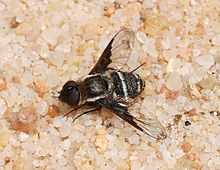Exhyalanthrax
| Exhyalanthrax | |
|---|---|
 | |
| Exhyalanthrax afer (Fabricius, 1794) | |
| Scientific classification | |
| Kingdom: | Animalia |
| Phylum: | Arthropoda |
| Class: | Insecta |
| Order: | Diptera |
| Suborder: | Brachycera |
| Infraorder: | Asilomorpha |
| Superfamily: | Asiloidea |
| Family: | Bombyliidae |
| Subfamily: | Anthracinae |
| Tribe: | Anthracini |
| Genus: | Exhyalanthrax Becker, 1916 |
| Type species | |
| Anthrax vagans Loew 1862 | |
| Species | |
|
Set text | |
Exhyalanthrax is a small genus of bombyliid flies. Bombyliids are commonly known as bee flies due to their resemblance to bees.[1] Exhyalanthrax are found in the Afrotropical ecozone and the Palearctic ecozone. Exhyalanthrax spp. are pupal parasitoids.Exhyalanthrax afer has been reared from pupae of tachinid and ichneumonid parasitoids of Thaumetopoea pityocampa and from the pupae of this species and other Lepidoptera. It has also been bred from cocoons of Neodiprion sertifer. Several African species have been reared from the puparia of tsetse flies and from puparia of other Diptera. An Exhyalanthrax sp. has also been found preying on cockroach, (Heterogamisca chopardi Uvarov) oothecae in Saudi Arabia. It has been suggested that Exhyalanthrax might be utilised as biological control agents especially in the battle against tsetse flies.
Species List
- This list is incomplete; you can help by expanding it.
- E. abruptus (Loew 1860)
- E. afer (Fabricius 1794)
- E. argentifer Becker 1916
- E. canarionae Báez 1990
- E. collarti François 1962
- E. contrarius Becker 1916
- E. melanchlaenus (Loew 1867)
- E. muscarius (Pallas 1818)
- E. simonae (François 1970)
- E. vicinalis Hesse, 1956